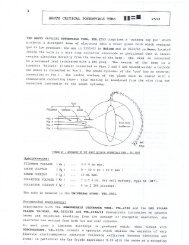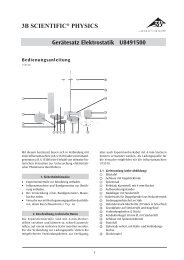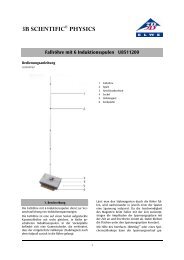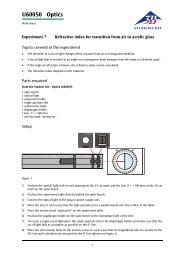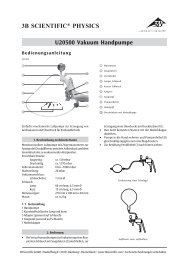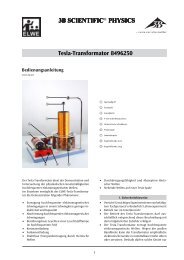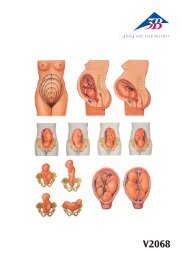SEK Heat U8502000
SEK Heat U8502000
SEK Heat U8502000
Create successful ePaper yourself
Turn your PDF publications into a flip-book with our unique Google optimized e-Paper software.
<strong>SEK</strong> <strong>Heat</strong> <strong>U8502000</strong><br />
Contents<br />
1 1 Capillary tube with red alcohol filling<br />
2 2 Thermometers<br />
3 1 Capillary tube�<br />
4 1 Metal beaker, black<br />
5 1 Metal beaker, aluminium<br />
6 1 Calorimeter with heating filament<br />
7 1 Holder for metal beaker<br />
8 4 g of glycerine<br />
9 5 ml of food colouring<br />
10 10 g of table salt<br />
11 2 Rubber stoppers with one hole<br />
12 1 Rubber stopper with two holes<br />
13 1 Test tube<br />
14 1 Measuring cylinder<br />
15 1 Hose<br />
16 1 Conical flask<br />
17 1 Beaker<br />
18 1 Metal tube, short<br />
19 2 Double clamps<br />
3B Scientific GmbH • Rudorffweg 8 • 21031 Hamburg • Germany • www.3bscientific.com<br />
Subject to technical amendments<br />
© Copyright 2010 3B Scientific GmbH<br />
20 1 Bimetal strip<br />
21 1 Aluminium tube<br />
22 1 Steel tube<br />
23 1 Brass tube<br />
24 Stand rod with internal and external threads<br />
25 4 Wooden rods<br />
26 1 Spirit burner<br />
27 1 Pointer/hook<br />
28 10 Sheets of thermal paper<br />
29 1 Test tube holder<br />
30 1 Stirrer<br />
31 10 Round filters<br />
32 3 Flow spirals<br />
33 2 Round gaskets<br />
34 1 Steel body and 1 lead body<br />
35 1 10 g weight<br />
36 1 Angle scale<br />
37 10 Sheets of paper<br />
38 5 Sheets of aluminium foil
<strong>SEK</strong> Thermodynamics/<strong>Heat</strong><br />
Work sheet<br />
K303 Specific heat capacity of a calorimeter<br />
Exercise<br />
� Determine by experiment the specific heat capacity C Kal of a calorimeter.<br />
Equipment<br />
From <strong>SEK</strong> Thermodynamics (<strong>U8502000</strong>)<br />
1 Stand rod with internal and external threads<br />
1 Double clamp<br />
1 Spirit burner<br />
1 Test tube holder<br />
1 Conical flask<br />
2 Thermometers<br />
1 Calorimeter<br />
Additionally required<br />
1 <strong>SEK</strong> base plate (U8408035)<br />
Water<br />
Set-up and procedure<br />
1) Fill the metal beaker of the calorimeter with<br />
50 ml of water and put the lid on it.<br />
2) Push a thermometer through the rubber<br />
stopper in the lid of the calorimeter so that<br />
the tip of the thermometer is in the water but<br />
does not touch the bottom of the vessel.<br />
3) Measure the temperature of the water in the<br />
calorimeter � 1 and enter the value into the<br />
column Measurement 1 of the table.<br />
4) Screw the stand rod with external and internal<br />
threads into the base plate (see Fig. 1).<br />
5) Attach a double clamp to the rod at a height<br />
of about 20 cm and clamp a test tube holder<br />
into it.<br />
6) Fill a conical flask with 50 ml of water, clamp<br />
it into the test-tube holder and put a second<br />
thermometer into it.<br />
7) Put the spirit burner on the base plate and<br />
move the double clamp holding the flask till<br />
the flask is about 3 cm above the burner (see<br />
Fig. 1).<br />
8) Light the spirit burner and heat the water in<br />
the flask till it reaches a temperature of<br />
about 70°C.<br />
9) Put out the flame once the experiment is<br />
over by lowering the wick and putting the cap<br />
over it.<br />
1<br />
10) Take the test tube holder out of the clamp<br />
11) After about a minute, read off the temperature<br />
of the hot water � 2 and enter that value<br />
into the table<br />
12) Empty the water out of the conical flask into<br />
the metal beaker of the calorimeter and close<br />
the lid (see Fig. 2).<br />
13) Stir the water well, measure the temperature<br />
� m of the mixed water and enter the reading<br />
into the table.<br />
14) Now empty the water out of the metal beaker<br />
back into the conical flask and briefly rinse<br />
out the beaker with cold water.<br />
15) Fill the beaker with a fresh 50 ml of water,<br />
repeat the experiment and enter the results<br />
in column Measurement 2 of the table.<br />
Fig. 1<br />
Fig. 2



